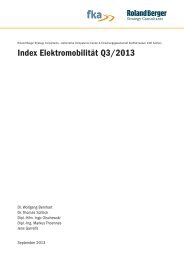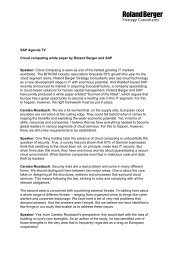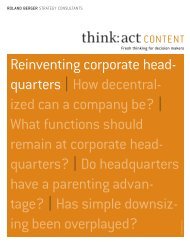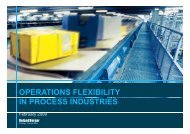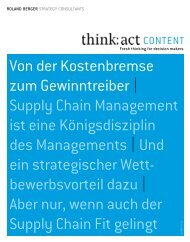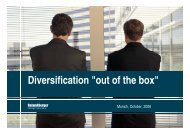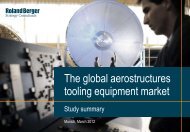"Automotive inSIGHTS 2/2010" (PDF, 3784 KB - Roland Berger
"Automotive inSIGHTS 2/2010" (PDF, 3784 KB - Roland Berger
"Automotive inSIGHTS 2/2010" (PDF, 3784 KB - Roland Berger
You also want an ePaper? Increase the reach of your titles
YUMPU automatically turns print PDFs into web optimized ePapers that Google loves.
MOBILITy CONCEpTS<br />
> Available: A vehicle may be only a negligible distance<br />
farther away than one's own would be. It must meet<br />
customers' requirements regarding model and features<br />
> Simple: Using the service must be no more complicated<br />
than "get in and turn the key" – but at the same<br />
time, there must be safeguards against misuse<br />
> Affordable: The total cost of ownership advantages<br />
over the traditional car purchase must be clear and<br />
passed on to the customer<br />
> Complete: To set itself apart from the traditional<br />
rental model, the mobility concept should combine<br />
various modes of transportation<br />
> Innovative and different: Especially in the startup<br />
phase, it is important to generate a high degree of<br />
media exposure to reach the minimum number of<br />
users and to stand out from existing car-sharing<br />
offers<br />
Besides an attractive offer and a large number of users,<br />
companies need sufficient infrastructure and the corresponding<br />
management know-how in services for these<br />
mobility concepts to be profitable over the long term.<br />
These requirements are currently best met by car rental<br />
companies. Manufacturer-driven models can be successful<br />
if they rigorously build up their own access to networks<br />
and know-how, or buy it in via collaborative partnerships<br />
or acquisitions, such as the partnership between<br />
Daimler's car2go and Europcar wich has been<br />
establisehed.<br />
Against this backdrop, manufacturers need their own<br />
mobility strategies. Manufactures have to evaluate the<br />
importance of changing mobility behavior in light of the<br />
resulting risks and opportunities, and develop strategies<br />
to respond to these changes.<br />
Carmakers, car rental companies and mobility service<br />
providers such as railway companies have to determine if<br />
comprehensive mobility concepts are the "next big thing"<br />
for them. They need to figure out when a true breakthrough<br />
can be expected and to what extent their existing business<br />
models need to be adapted and expanded. These<br />
important points clearly need to be decided at the upper<br />
management levels.<br />
Ralf H. Landmann<br />
Partner,<br />
<strong>Roland</strong> <strong>Berger</strong> Strategy Consultants, Frankfurt<br />
ralf_landmann@de.rolandberger.com<br />
Sebastian Gundermann<br />
Project Manager,<br />
<strong>Roland</strong> <strong>Berger</strong> Strategy Consultants, Frankfurt<br />
sebastian_gundermann@de.rolandberger.com<br />
Jan-philipp Hasenberg<br />
Senior Consultant,<br />
<strong>Roland</strong> <strong>Berger</strong> Strategy Consultants, Frankfurt<br />
jan-philipp_hasenberg@de.rolandberger.com<br />
13



